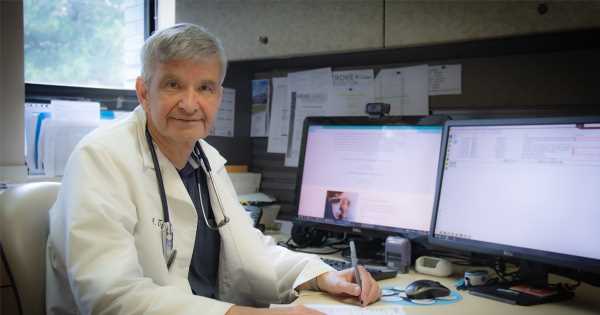Photo: Awab Sattar
Dr. Richard Tytus of Hamilton, Ontario, is a medical professional with extensive experience in delivering and promoting virtual healthcare. He has been providing telemedicine long before the COVID-19 pandemic. He is a clinic owner and part of a family health team of approximately 30 medical professionals and allied health workers.
THE PROBLEM
“My journey into telemedicine was sparked by a genuine concern for a subset of patients facing physical or psychological barriers to accessing healthcare,” he said. “Some patients have psychological conditions that cause overwhelming apprehensions about leaving their homes, often preventing them from seeking essential medical consultations.
“Even though telephone calls have been a part of my medical practice for quite some time, the introduction of video conferencing offered a subtle way to integrate exposure therapy with their treatment,” he explained.
PROPOSAL
His initial plunge into telemedicine was improvising using conventional video conferencing tools for medical consultations. As the virtual care horizon expanded, he explored some of the telehealth systems.
“Beyond mere consultations, the vision of these systems broadened to encompass a digital ecosystem,” Tytus said. “A space where a patient’s journey, from administrative check-ins to specialist consultations, would be seamless and safeguarded. A realm where the transition from a receptionist to a nurse, then a doctor, and if need be, a specialist, would be as effortless as walking through interconnected rooms in a physical clinic.
“The initial hiccups and revelations in the world of telemedicine, while challenging, were instrumental,” he continued. “They painted a clearer picture of what the future of digital healthcare should and could look like. This wasn’t just about technology; it was about combining technology with the human touch, ensuring the essence of personalized care remained undiluted even in a virtual space.”
MARKETPLACE
There are many vendors of telemedicine technology and services on the health IT market today. Healthcare IT News published a special report highlighting many of these vendors with detailed descriptions of their products. Click here to read the special report.
MEETING THE CHALLENGE
Tytus’ journey into telemedicine past simple video conferencing led him to a platform from vendor Banty that not only is fortified in terms of security but also has governmental validation, he noted.
“This assurance is underpinned by its successful penetration tests and its alignment with the ISO 27001 certification, which is a testament to its data protection robustness,” he said. “The government verified and validated video platform that I use is not merely a video consultation between a clinician and a patient, it is the foundational support software for the digital transformation of healthcare in the other operating verticals of a family healthcare clinic, specialty clinics and small hospitals.
“One of the standout features of this platform is its facilitation of smooth, intra-team communication,” he continued. “It allows our medical team to swiftly determine the availability of fellow physicians and specialists, enabling instant messaging capabilities and the seamless transfer of patients along with pertinent medical notes.”
Furthermore, the tool’s adaptability deserves special mention, he added.
“It’s EHR-agnostic, meaning it’s engineered to harmoniously operate with any of the numerous electronic health records systems prevalent in North America, making it versatile and accommodating to diverse infrastructural setups,” he explained.
RESULTS
One of the most profound achievements, Tytus said, has been dismantling the obstructions patients faced regarding medical accessibility.
‘”We’ve elevated our standard of care, ensuring patients receive the same caliber of medical attention virtually as they would during an in-person visit,” he said. “By pioneering a hybrid clinic model – where certain procedures are conducted in-person while others transition to a virtual domain – we’ve not just alleviated accessibility challenges but also enhanced our operational efficiency.
“This strategic shift has translated to a quantifiable increase in patient consultations,” he continued. “To put it in numbers, each physician within our family health team now manages to attend to an additional six to eight patients daily, a testament to the transformative power of integrating telemedicine into our practice.”
This approach has redefined how patients perceive healthcare, he added.
“No longer is it a choice between virtual or in-person; it’s about what’s best suited for each specific need,” he said. “The fusion of traditional and telemedicine techniques ensures every patient gets timely attention, regardless of their physical location or mobility constraints.
“Moreover, the technology’s intuitive design and smooth integrations have empowered our healthcare professionals,” he continued. “They now can focus more on patient care rather than wrestling with technological barriers. The ability to quickly connect with colleagues, discuss cases and transfer patients, all within a secure environment, has streamlined our operations.”
The ripple effects of this efficiency are felt not just in numbers but in the enhanced patient satisfaction and the morale of the medical team, he added.
ADVICE FOR OTHERS
“Foremost, patient usability should be at the heart of any telemedicine platform,” Tytus advised. “It’s imperative the system is intuitive and user-friendly, minimizing any potential technological hurdles for patients.
“After all, the ultimate goal is to simplify access to healthcare, not compound it with additional complexities,” he said. “Simultaneously, the platform should offer seamless integration for healthcare professionals. Doctors and healthcare teams should be able to effortlessly incorporate it into their daily operations without facing a steep learning curve.”
And the design should be team-centric, mirroring the intricate patient pathways and workflows that are characteristic of clinics nationwide, he said.
“A one-size-fits-all approach will not suffice; customization and adaptability are key,” he concluded.
Follow Bill’s HIT coverage on LinkedIn: Bill Siwicki
Email him: [email protected]
Healthcare IT News is a HIMSS Media publication.
Source: Read Full Article
